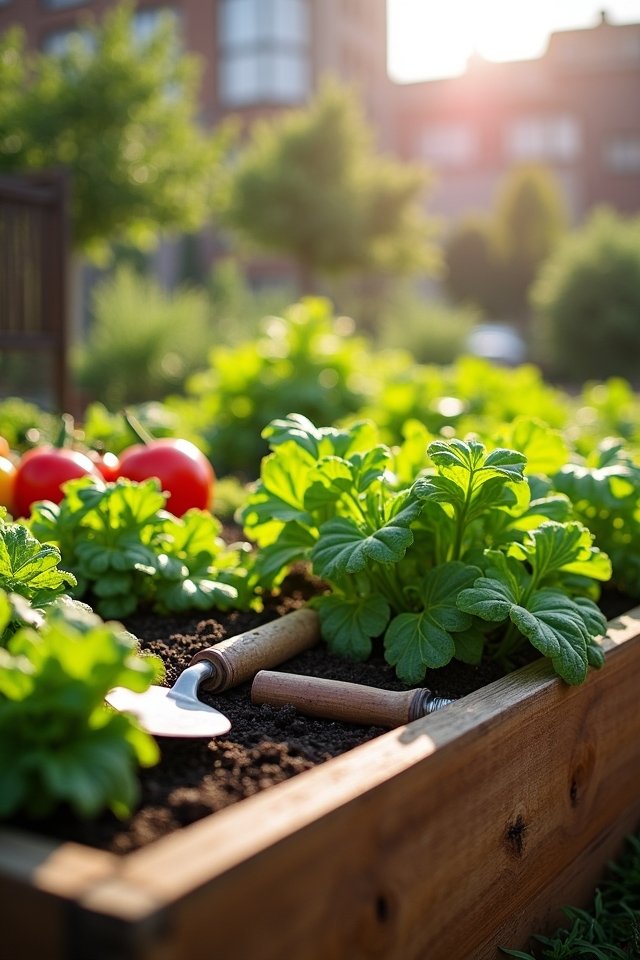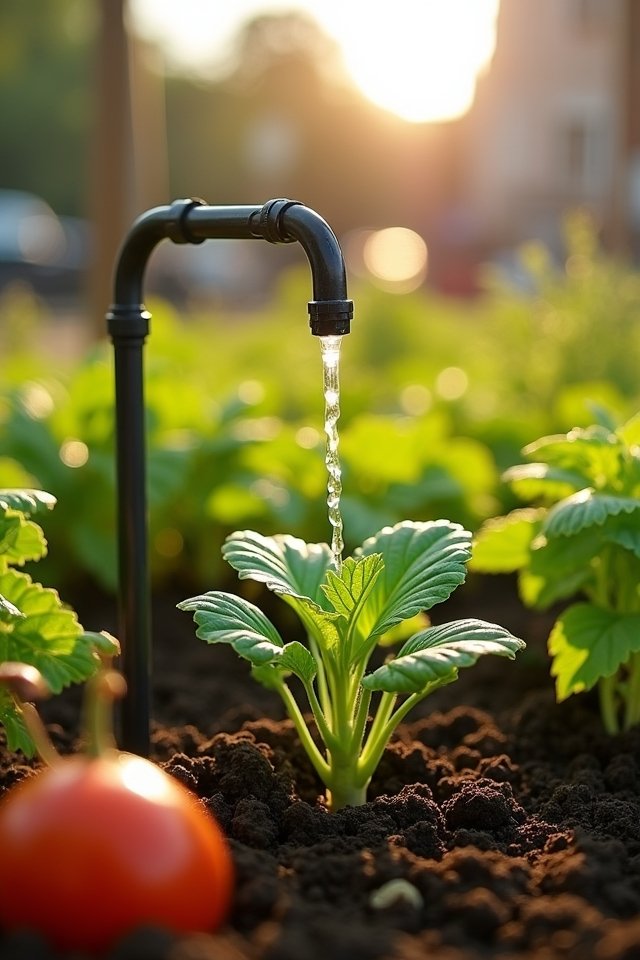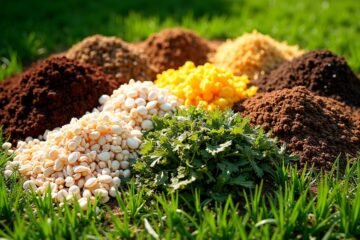Want a flourishing organic garden, but feeling pressed for time? Start with low-maintenance plants like succulents or vibrant Black-eyed Susans—blooming beauties that attract pollinators! Raised garden beds make reaching your veggies a breeze, while drip irrigation systems serve up water right at the roots. Don’t forget mulch to keep pesky weeds at bay. Sprinkle in quick 15-minute maintenance sessions, like snipping back a few leaves, and you’ll be amazed at what you can grow! Curious for more gardening secrets?
Choose Low-Maintenance Plants

When it comes to choosing low-maintenance plants, think of them as your gardening best friends! You want vibrant green without the headache, right? Drought resistant varieties like succulents or lavender are perfect—they’ll thrive where others wilt. Native plants are like the superheroes of the garden, requiring little water and zero fuss. Imagine the bright blooms of Black-eyed Susans waving hello without you breaking a sweat! They’re not just beautiful; they attract pollinators and support local ecosystems. Plus, who couldn’t use a little more color without the gardening drama? So, ditch those picky plants, and welcome these low-maintenance wonders. Your future self, sipping lemonade on the porch, will thank you for it! Ready to level up your gardening game?
Utilize Raised Garden Beds

Ready to take your gardening experience up a notch? Utilizing raised garden beds can truly elevate your green-thumb game! Envision this: effortlessly organized rows of vibrant vegetables, all while enhancing soil health! The raised bed advantages are numerous—better drainage, warmer soil, and easier access when you’re short on time. Just imagine plucking fresh tomatoes or crisp lettuce without bending down!
You’ll love how the soil stays rich and nutrient-packed, perfect for healthy plants. Plus, you can customize the height, so no more backaches! Consider using durable materials like cedar or recycled wood; they add charm and keep pests at bay. Immerse yourself in this innovative gardening method, and watch as your hobby transforms into a blooming success! Isn’t that exciting?
Implement Drip Irrigation Systems

Imagine walking through your garden and seeing each plant thriving, thanks to a little secret weapon: drip irrigation systems! These nifty setups deliver water directly to the roots, giving your plants just the right amount without the hassle of constant watering. The drip irrigation benefits are incredible! You’ll save water, reduce weeds, and free up time—who wouldn’t want that?
For installation tips, start by mapping out where each plant lies, then lay the tubing for precise delivery. Use stakes to secure everything in place; it’s like giving your plants their own private spa treatment! Just picture lush tomatoes and vibrant peppers flourishing effortlessly. So, get ready to adopt innovation and transform your gardening experience! You’ll thank yourself later! Happy watering!
Plan Your Garden Layout Efficiently

Before you plunge into planting, it’s essential to create a solid garden layout—after all, a well-planned garden is like a good book, drawing you in and keeping you engaged! Think about your garden design like a puzzle; every piece must fit just right for peak beauty and function. To maximize your space optimization, consider raised beds or vertical gardening. These options not only save space but also create a stunning visual impact! Scatter colorful flowers amongst your veggies for a delightful surprise! Now, don’t forget to account for sunlight and water flow; mapping out these elements helps prevent future headaches. So, grab some graph paper, let your imagination run wild, and watch your perfect garden take shape! Your green thumb is ready!
Use Mulch for Weed Control

Now that you’ve laid out your garden like a masterpiece waiting to bloom, it’s time to tackle those pesky weeds! Using mulch is like wrapping your plants in a cozy blanket, keeping them warm and protecting them from unwelcome intruders. Explore different mulch types—wood chips, straw, or even shredded leaves—each offering unique beauty and benefits for weed prevention. Spread a thick layer, about three inches deep, to smother those stubborn weeds that crave sunlight. Plus, it retains moisture, so your plants thrive! It’s a win-win situation! So, why not give those weeds a run for their money? With a little mulch magic, your garden will flourish, and you can spend your time admiring instead of weeding!
Schedule Quick Maintenance Sessions

While you might feel overwhelmed with all the tasks that come with gardening, scheduling quick maintenance sessions can be a game changer! Just think—fifteen minutes here or there can keep your garden thriving without eating into your day. Here are a few easy tasks to fit into your busy routine:
- Watering: Use a rain barrel to catch storms and make watering super efficient!
- Weeding: Can’t ignore those pesky little guys! Pull them while you’re waiting for a pot to boil.
- Pruning: Just like a haircut, a little trim goes a long way to keeping your plants healthy!
Frequently Asked Questions
How Often Should I Water My Low-Maintenance Plants?
You’ll want to water your low-maintenance plants based on their drought resistance. Generally, every 1-2 weeks is ideal, but check the soil! If it feels dry an inch down, it’s time for a drink! Think of it like a rejuvenating spa day for your plants! Too much water can drown them, so balance is key. Remember, each plant’s a unique individual with its own watering frequency needs—treat them well, and they’ll flourish!
What Soil Type Is Best for Raised Garden Beds?
Choosing the right soil for your raised garden beds is like picking the perfect cake batter! You’ll want a blend that’s rich and fluffy, ideally a mix of loamy soil and quality compost. Adding soil amendments like worm castings or peat moss can work wonders, creating a nutrient haven for your plants. Imagine thriving veggies dancing in the nutrient-rich soil! So, give your plants the pampering they deserve—your garden will thank you!
Can I Use Regular Hoses Instead of Drip Irrigation Systems?
Sure, you can absolutely use regular hoses instead of fancy drip irrigation systems! While hoses might not match the watering efficiency of a drip setup, they can still get the job done—think of them as trusty steeds in your gardening adventure! Just remember to move them around for even watering, like a dance across your garden. If you want to save water, consider hose alternatives like soaker hoses. They can be a real game-changer!
What Vegetables Grow Well in Small Garden Layouts?
Got a tiny patch or some pots on your balcony? You’re in luck! Container gardening opens a world of space-saving vegetables like cherry tomatoes, radishes, and leafy greens. Picture nibbling on fresh basil while its delightful aroma fills the air! Carrots grow happily in deep pots, while bush beans keep the excitement alive with their vibrant green leaves. Who knew you could grow a garden in a shoebox? Happy planting!
How Can I Tell if Mulch Is Breaking Down Properly?
Mulch can be a garden’s best friend—or a messy foe! Check its texture; if it feels crumbly and soft, you’re on the right track. Look for decomposition indicators like earthworms or moisture retention—those little guys know what’s up! If it’s still woody or dry, it might be taking a nap instead of breaking down. Give it a stir occasionally, and soon, you’ll have that rich, dark compost heaven! Isn’t nature clever?


